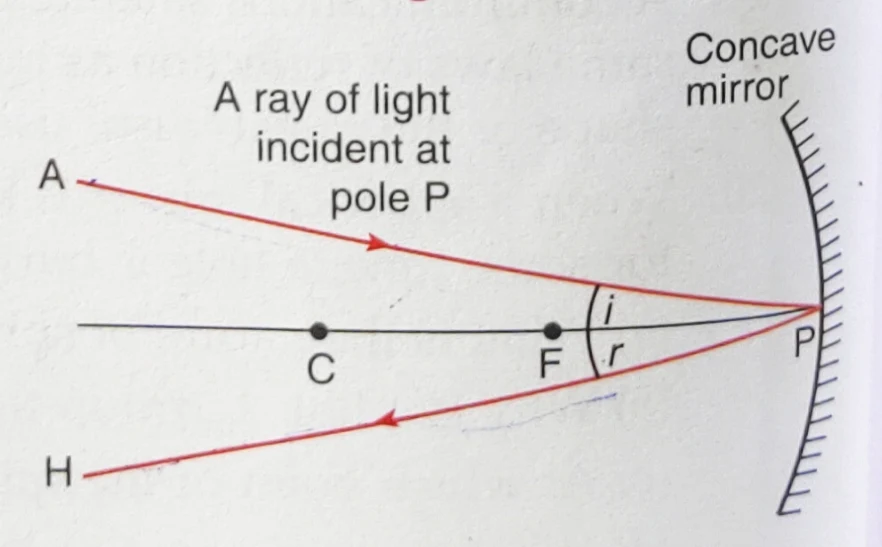CLASS X | SCIENCE | LIGHT
Notes prepared by Subhankar Karmakar
click to access other class notes
• Rules for obtaining images formed by Concave Mirror:
The image will be formed at the point where atleast two reflected rays intersect or appear to intersect.
1. A ray of light which is is parallel to the principal axis of a concave mirror, passes through its focus after reflection from the mirror.
2. A ray of light passing through the centre of curvature of a concave mirror is reflected back along the same path. Arrow pointing from left to right indicates the direction of incident ray and the arrow pointing from right to left indicates the direction of reflected ray.
3. A ray of light passing through the focus of a concave mirror becomes parallel to the principal axis after reflection.
4. A ray of light which is incident at the pole of a concave mirror is reflected back making the same angle with the principal axis.
• If a ray of light is incident on a concave mirror along its principal axis, then it is reflected back along the same path.
• FORMATION OF DIFFERENT TYPES OF IMAGES BY A CONCAVE MIRROR
The type of image formed by a concave mirror depends on the position of object in front of the mirror. At different places, an object produces different types of images.
a. When the object is in between Pole (P) and focus (F):
When an object is placed between the pole (P) and focus (F) of a concave mirror, the image formed is:
i. Behind the mirror
ii. Virtual and erect, and
iii. Larger than the object or magnified.
Uses of concave mirror using this type of images:
1. A concave mirror can be used to magnify objects. Therefore, it will be used as a magnifying glass.
2. A concave mirror can be used as a makeup mirror. It magnifies a part of the face.
3. Dentist's mirror is a small concave mirror fitted in a frame with a long handle. It gives magnified image of tooth.
b. When the object is placed at the focus (F) of a concave mirror:
i. At infinity,
ii. Real and inverted, and
iii. Highly magnified.
Uses of concave mirror using this type of images:
1. When a light bulb is placed at the focus of a concave mirror reflector, the diverging light rays off the bulb are collected by the concave reflector and then reflected to produce a strong, parallel beam of light.
c. When the object is placed between focus (F) and centre of curvature (C):
When an object is placed between the focus (F) and the centre of curvature (C) of a concave mirror, the image formed is:
i. Beyond the centre of curvature
ii. Real and inverted, and
iii. Larger than object or magnified.
d. When the object is placed at the centre of curvature (C) of a concave mirror:
i. At the centre of curvature (C),
ii. Real and inverted, and
iii. Same size as the object.
e. When the object is is beyond the centre of curvature (C) of the concave mirror:
i. Between the focus (F) and the centre of curvature (C),
ii. Real and inverted, and
iii. Smaller than the object or diminished.
f. When the object is at infinity:
i. At the focus (F),
ii. Real and inverted, and
iii. Much smaller than the object or highly diminished.
"This means that a concave mirror can concentrate all The parallel rays of light to its focus."
Uses of concave mirror using this type of images:
1. A concave mirror is used as a "head mirror" by the doctors to concentrate light coming from a lamp onto the body part of a patient like ear, nose, throat etc. to be examined.
2. The concave "metal dishes" are used in dish antenna of televisions to receive TV signals from the very distant communication satellite which are high up in the sky.
USES OF CONCAVE MIRRORS:
1. A concave mirror can be used to magnify objects. Therefore, it will be used as a magnifying glass.
2. A concave mirror can be used as a makeup mirror. It magnifies a part of the face.
3. Dentist's mirror is a small concave mirror fitted in a frame with a long handle. It gives magnified image of tooth.
4. When a light bulb is placed at the focus of a concave mirror reflector, the diverging light rays off the bulb are collected by the concave reflector and then reflected to produce a strong, parallel beam of light.
5. A concave mirror is used as a "head mirror" by the doctors to concentrate light coming from a lamp onto the body part of a patient like ear, nose, throat etc. to be examined.
6. The concave "metal dishes" are used in dish antenna of televisions to receive TV signals from the very distant communication satellite which are high up in the sky.











No comments:
Post a Comment